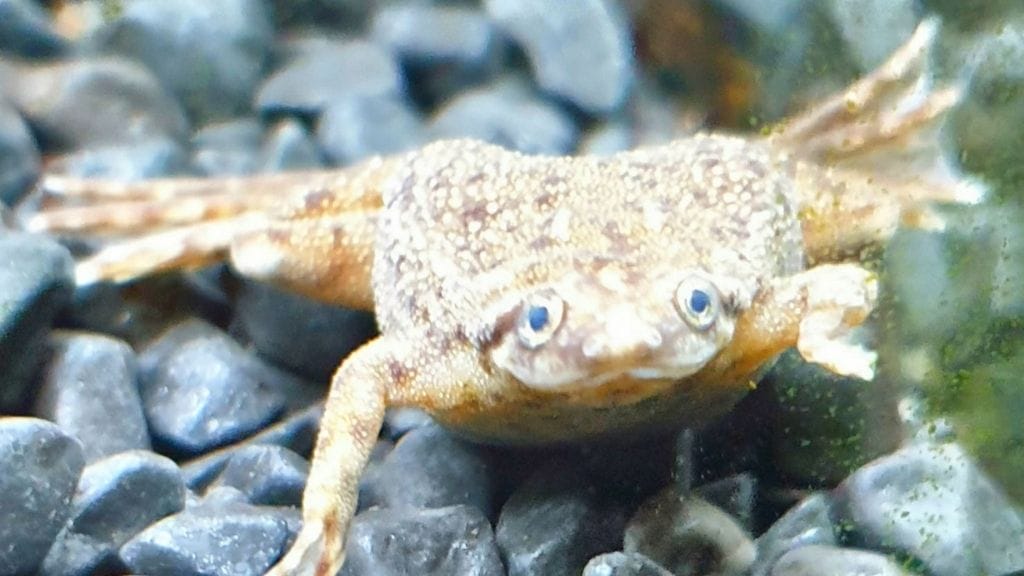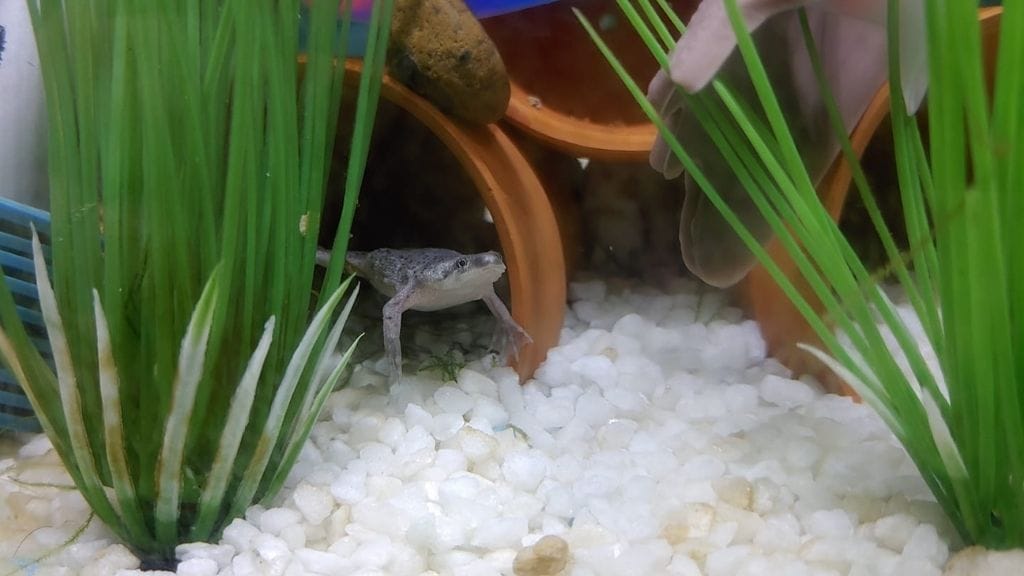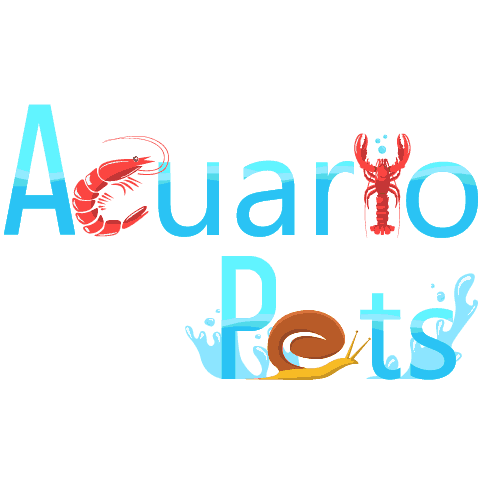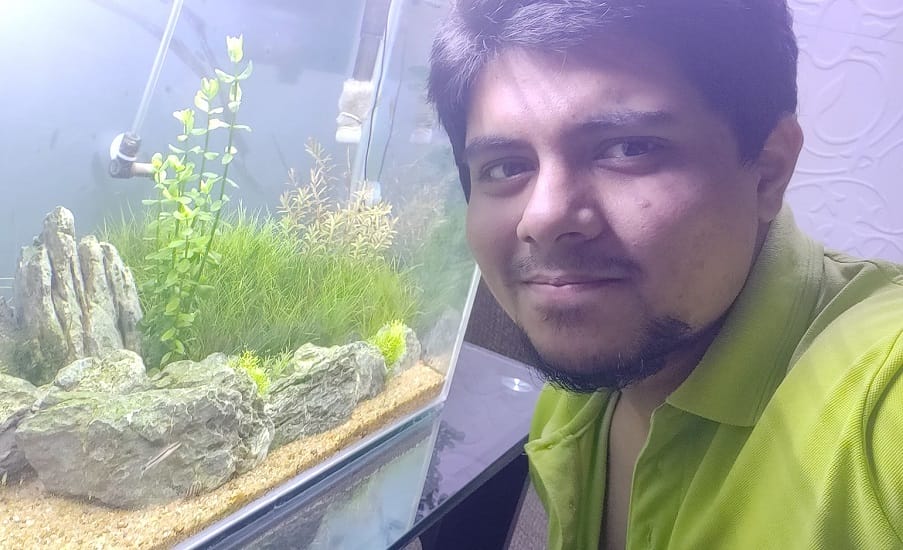This post was created with help from AI tools and carefully reviewed by a human (Muntaseer Rahman) . For more on how we use AI on this site, check out our Editorial Policy.
Check Out These FREE Tools We Made JUST For You!
Why My African Dwarf Frog Has Fuzzy Foot?

Keeping a fully aquatic frog-like African dwarf frog is a difficult task to do. Despite nourishing your frogs so well, you might get worried after noticing the fuzzy foot of your African dwarf frogs. Sometimes, the new owners might confuse fuzzy feet with shedding skin too. So, the question arises among frog owners- why does my African dwarf frog have a fuzzy foot?
The fuzzy foot of African dwarf frogs is not a usual issue of shedding.
If your African dwarf frogs have fuzzy feet, your frog may get infected with fungal infection. The chytrid fungus can be held responsible for the sores or fuzziness of the African dwarf frog foot.
In this article, I’ve explained the symptoms, causes, treatments, prevention, and other details of fungal infection in African dwarf frogs. If your African dwarf frog has a fuzzy foot, you should continue reading this article.
Causes of African Dwarf Frogs Fuzzy Foot
You might wonder what can be responsible for such awful conditions of African dwarf frogs. The root cause behind the fuzzy foot of African dwarf frogs is a fungal infection.
Chytridiomycosis is responsible for the fuzzy foot of African dwarf frogs. In an initial state, the fungus may affect the tadpoles.
Later, it gets spread to the adult frogs. Moreover, the infected water plays a vital role in spreading this fungus to African dwarf frogs.
Symptoms Of Fungal Infection
When a frog gets infected by Chytridiomycosis, this fungus will primarily attack the skin. The common sign of this fungal infection is white, cottony patches on throw affected foot.
The affected skin becomes thicker since the fungus tends to eat the keratin of the skin. As a result, the infected African dwarf frog will face difficulty breathing through its skin.
Sometimes, the sore skin might come off as if the frog were shedding. But, you can readily differentiate it from natural shedding.
When a frog sheds, the skin comes off as a whole. On the contrary, an affected frog will shed its skin into pieces. The condition worsens, leading to a heart attack in the infected frog.
Besides, your dwarf frog will be sluggish and show abnormal behavior. You might also notice the abnormal postures of the hind legs of African dwarf frogs when your frog is infected with chytrid fungus. Constriction of the pupils of the eyes of infected frogs might be visible.
African dwarf frogs might die for several reasons. You can know details about such 10 other causes and prevention in this article.
Want to get a printable version of this infographic? Click here! [If you want to use this infographic on your website, please link back to this post as the source!]
How Do You Treat A Fungal Infection In African Dwarf Frogs?
Undoubtedly, Chytridiomycosis is a deadly fungus that leaves an amphibian in great suffering. Several types of medications are available for treating fungal infections in African dwarf frogs. But, all of them may not work upon the body of the infected frogs.
Medications
In the initial stage, some medications can be effective for your frog. Such as- Itraconazole, Benzalkonium chloride.
You need to mix benzalkonium chloride with around 2 mg per 1 liter of water. Then, you should bathe your infected African dwarf frogs in that mixture.
Some other commercial antifungal medications are PIP Pond Plus, Mandipropamid, SteriPlant, etc. But, you must take the suggestion of your vet before applying any of these medications. Sometimes, a low dose of these treatments may get fatal to your affected dwarf frogs.
Another latest medication for fungal treatment is Janthinobacterium lividum. If your vet suggests it, you can apply this on your infected dwarf frog.
Another popular method of treating fungal infection is heat treatment for amphibians. You can apply it to your African dwarf frogs when they have a fuzzy feet.
Heat Treatment
The experts found out that the fungus becomes weak above the temperature of 25-32 degrees Celsius for frogs. For this heat treatment, you should keep your infected African dwarf frog at an exposure of 25 degrees Celsius for 7 days.
The fungus is supposed to be killed within 7 days under this heat. You can install a heater in the tank of your infected dwarf frog. Don’t forget to adjust a thermometer to monitor the temperature range.
Quarantine
If the symptoms match with chytrid fungus, you should quarantine your African dwarf frogs. Don’t forget to follow the instructions for hygiene.
Afterward, you should increase the heat at the higher end of their temperature range in the tank. It’ll help lower the strength and growth of the fungus. As a result, the medications will work better on the infected dwarf frog.
If you are curious about other health problems of African dwarf frogs, you can check this out to know about the treatments: 12 African Dwarf Frog Health Problems
How To Stop The Spreading Of Chytrid Fungus?
If you have multiple pet frogs, a fungal-infected frog will be risky to other healthy frogs. So, you must take effective initiatives to stop the spreading of chytrid fungus among other frogs.
Let’s see what you can do to inhibit the spreading of chytrid fungus.
- The first thing that you should do is to separate and quarantine your fungal-infected frog.
- You should not touch your infected dwarf frog without necessary. If you need to touch your sick frog, you should take proper protection.
- Disinfect the frog tank and all items in the tank.
- Do not forget to change the water of the infected dwarf frog tank. The spores of chytrid fungus can swim at a small distance.

How To Kill The Chytrid Fungus In The Aquarium Of African Dwarf Frogs?
If your African dwarf frog is infected by the chytrid fungus, you should ensure to make the tank free of fungus infection. You need to take some steps to kill the chytrid fungus in the aquarium of your African dwarf frogs.
Firstly, you have to remove the infected dwarf frog and keep it in another tank. You should also throw away the plants as these plants might have the presence of fungus spores. If your infected dwarf frogs have other tank mates, you should quarantine them too.
Secondly, you should remove the water from the tank. Besides, it would help if you vacuumed the substrate well.
Afterward, you should increase the temperature of the tank slowly. Rise the temperature to around 104 degrees Fahrenheit. The fungi will die within 6-7 hours in this high temperature.
To ensure safety, you can disinfect the equipment and décor items of the tank of your African dwarf frogs. For this, you should spray the mixture of water and vinegar in equal proportion.
You can also scrub the floor and lid of the tank. Then, you should clean the entire tank with hot water. After cleaning thoroughly, you should let the equipment dry properly.
If you follow these steps, the chytrid fungus will be killed within a few days. But, you should leave the aquarium for around 3 months without fish or frogs. As chytrid fungus spores live on keratin, the fungus will not survive without any exposure to the skin of your frog.
Prevention of Chytrid Fingus In African Dwarf Frog Tank
To prevent fungus in your frog tank, you should first know what triggers the growth of the fungus The common reasons for developing fungus in an aquarium are low temperature, poor water quality, and so on. There are a few steps that can prevent chytrid fungus. These are-
- Make sure to remove the leftovers after feeding your African dwarf frogs and their tank mates.
- Keep the aquatic environment clean and hygienic. You need to add a filter to keep the water fresh.
- You should keep the temperature range a bit high. It’ll prevent the growth of fungus in the aquarium.
- However, you might have noticed that fungal growth is rare in saltwater. So, you can add around 1-3 gm of salt per liter of water in your frog tank.
Final Words
I hope this article helped you gain a clear idea of the reason for African dwarf frogs’ fuzzy feet. You should take the necessary steps to prevent fungal infection among your dwarf frogs. Also, you must not forget to take the suggestions of a vet in such a condition when your frog has a fuzzy foot.
About Author
Hello, I’m Muntaseer Rahman, the owner of AcuarioPets.com. I’m passionate about aquarium pets like shrimps, snails, crabs, and crayfish. I’ve created this website to share my expertise and help you provide better care for these amazing pets.
Disclaimer
This site is owned and operated by Muntaseer Rahman. AcuarioPets.com is a participant in the Amazon Services LLC Associates Program, an affiliate advertising program designed to provide a means for sites to earn advertising fees by advertising and linking to Amazon.com. This site also participates in other affiliate programs and is compensated for referring traffic and business to these companies.


